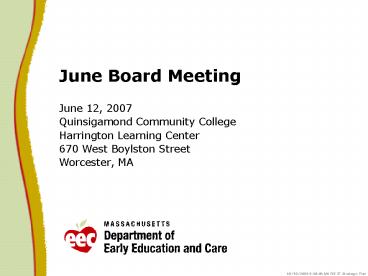June Board Meeting - PowerPoint PPT Presentation
1 / 14
Title: June Board Meeting
1
June Board Meeting
- June 12, 2007
- Quinsigamond Community College
- Harrington Learning Center
- 670 West Boylston Street
- Worcester, MA
2
Workforce Development System Building Update
3
2 Yr Community Colleges
Private Universities
4 Yr State College System
Higher Education/ Scholarships
Professional Organizations Institutes
Cultural Organizations
Voc/Tech School
Consultants Trainers
Workforce Training Funding Delivery
USDA Food Programs
Other State Agencies
Early Education Care Workforce
21st Century Program
DPH
EEC
DOE
CPCs
CCRRs
ESL Adult Literacy Programs
Head Start
Green funding Red delivery
4
Workforce Development System Building
- Current EEC efforts based on
- Guiding Principles
- Legislative Requirements
- Framework provided by 2006 Workforce Plan
- Research and analysis of "current state" and best
practices and - Whats good for children, educators, programs,
and families.
5
Workforce Development System Building Principles
- Involve and engage stakeholders
- Include all staff roles and levels
- Build on strengths of the current workforce
- Provide a continuum of opportunities that are
accessible and meet the diverse needs of the
workforce - Develop and recognize leadership at all levels
- Set high standards and provide the supports to
meet and maintain them - Promote equity across public and private systems
- Link career advancement to compensation
- Establish best practices based on current
research - Maintain a balance among access, affordability,
and quality across the system.
6
Workforce Development System Building Legislative
Requirements (M.G.L Chapter 15D Section 5)
- An inventory of current workforce resources
- Analysis of current status of workforce
- Assessment of workforce capacity to meet future
needs - Core competencies
- Streamlined certification, credentialing and
licensure - Professional development registry
- Statewide articulation agreements among higher
education institutions - Training and trainer approval
- Coordination of existing workforce resources
among public agencies regional workforce
supports - A range of professional development
opportunities - Credit for prior learning experiences/equivalencie
s - Career ladder/lattice
- Public and private resources to support workforce
development efforts and - Data collection and evaluation system to assess
whether workforce plan is achieving desired
outcomes.
7
Workforce Development System Building Key
Elements
- State-Wide Infrastructure Building, Leadership
and Strategic Planning - Core Competencies
- Professional Development Data Management System
- Credentialing and Career Lattice (Career
Pathways) - Professional Development Opportunities and
Resources Aligned with Requirements and Workforce
Needs
8
Workforce Development System Building Progress
To Date - Highlights
- Addressed and aligned training and professional
development requirements in draft of proposed
regulations. - Conducted an online survey of CCRRs, CPCs,
Family Child Care Systems, and Head Start
programs to gather information on professional
development. - Compiled an initial draft of core competencies to
apply across the field. - Updated existing Professional Qualifications
software created on-line application. - Developed a comprehensive background check system
to safeguard children which includes results of
substantiated DSS investigations and criminal
offender record information (CORI).
9
Workforce Development System Building Key Next
Steps
- Convene Workforce Development Task Force in
collaboration with United Way of Mass Bay and the
Schott Foundation. - Build EEC internal workforce development
capacity. - Continue to collect and analyze data on current
state including assessing statewide professional
development needs. - Begin building IT infrastructure for EEC
Professional Development Data Management System. - Work with Board of Higher Education to develop
statewide articulation/transfer agreements.
10
Workforce Development System Building Key Next
Steps (continued)
- Seek feedback and finalize Core Competencies.
- Design a basic EEC Orientation program for all
educators entering the field. - Continue linking funding increases to
staff/program quality through Universal Pre-K
(UPK), and other quality initiatives. - Identify critical resource gaps and develop FY
2009 budget priorities to begin addressing most
critical needs.
To view a copy of the 2007 Workforce Update
please visit the EEC Website at
www.eec.state.ma.us
11
Workforce Development System Building Workforce
Development Task Force
- Membership
- Key experts and others with hands-on experience
in workforce development issues. Representation
from state agencies, direct service providers,
training providers, higher education, funders,
business, and others. - Charge of Task Force
- Provide expert feedback and refinement on
existing workforce plans - Develop achievable, actionable strategies and
meaningful next steps for short term
implementation and - Serve an advisory capacity to EEC on the further
development of EECs long term plan for workforce
development. - Structure and Timeline
- Monthly meetings with multiple sub-committees
- Scheduled to meet June 2007 June 2008
12
EEC Financial AssistanceState Median Income
(SMI) Update
13
Updating Income Eligibility for EEC Financial
Assistance
- CURRENT INCOME ELIGIBLITY REQUIREMENTS
- All Based on 2006 State Median Income (SMI)
- ? Entry 50SMI or below
- ? Exit 85SMI
- Family with documented special need
- ? Entry 85SMI or below
- ? Exit 100SMI
- RECOMMENDATION
- Use 2008 State Median Income to update Income
Eligibility Levels to more closely reflect
current cost of living. - IMPACT
- Updating to 2008 SMI will result in an increase
in the income eligibility level of 100 month at
the 50 SMI entry level, and of 150-225/month
increase at the 85 SMI. A small number of
additional families will become eligible a small
number of families will remain eligible longer.
14
Comparison of Income Eligibility Levels 2006
vs. 2008Gross Income and of State Median
Income (SMI)
UPDATED EXIT
CURRENT EXIT
UPDATED ENTRY
CURRENT ENTRY
Example Based on a family of three, no
documented special need































